What is a HanFu| Something You Need to Know
Imagine a woman wearing a flowing green silk pao with jade decorations at a cultural event, embodying the revival of authentic Chinese culture.
Hanfu (汉服), the traditional attire of the Han ethnic group, spans over 3,000 years, from the Shang Dynasty to the Ming Dynasty, reflecting Chinese history and societal values.
This article explores how Hanfu evolved across dynasties like the Qin, Han, Tang, Song, and Ming, its suppression during the Qing Dynasty, and its modern resurgence as a symbol of cultural pride and Han Chinese identity.
Learn authentic Chinese from those who live and breathe the culture.
Specially tailored for kids aged 3-18 around the world!
Get started free!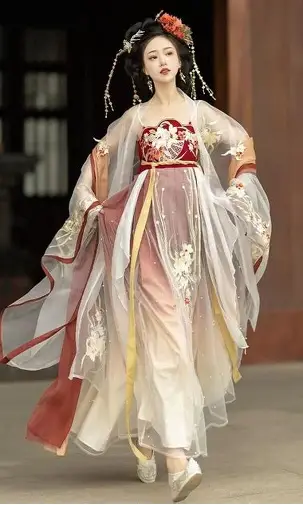
Historical Evolution of Hanfu
Origins: Shang and Western Zhou Dynasties
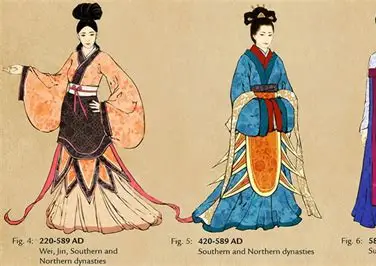
- Early Forms: Upper and lower garments (yichang) emerged in the Shang Dynasty, emphasizing hierarchical order. Silk production began, reserved for elites.
- Zhou Rituals: The Western Zhou Dynasty formalized attire worn during rituals, with narrow sleeves and distinct styles for ceremonies.
Unification and Refinement: Qin dynasty, Han dynasty, and Jin Dynasties
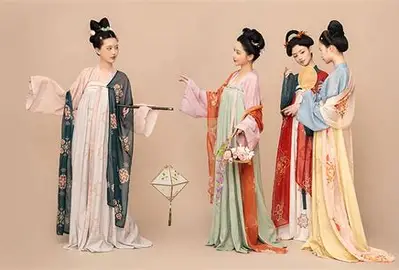
- Qin Dynasty: Standardized clothing colours (black for nobility) and upper outer garments.
- Han Dynasty: The Han ethnic group solidified Han clothing with cross-collar upper garments and wide sleeves. Women’s attire like ruqun (blouse-skirt) became iconic.
- Jin Dynasties: Influence from nomadic cultures introduced layered robes.
Golden Age: Tang Dynasty

- Cultural Fusion: Tang Dynasty Hanfu absorbed Persian and Central Asian elements. Women’s clothing featured high-waisted skirts (qun) and shawls (pibo).
- Silk Road Impact: Clothing style incorporated bold patterns and jade decorations, symbolizing wealth.
Simplification and Codification: Song to Ming Dynasties
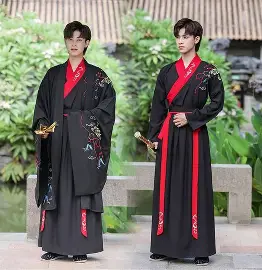
- Song Dynasty: Minimalist designs with slender silhouettes, reflecting Confucian modesty.
- Ming Dynasty: Revival of traditional Hanfu like aoqun (jacket-skirt) and zhiduo (straight robe), later seen as the “classic” form.
Hanfu Clothing Cultural Significance and Symbolism
Hanfu as a Marker of Identity
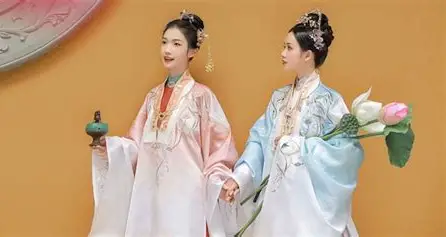
- Ethnic Pride: Hanfu distinguished the Han Chinese people from neighboring groups like the Manchu during the Qing Dynasty.
- Philosophical Roots: Daoist harmony (flowing sleeves) and Confucian order (layered robes) shaped traditional styles.
Social and Aesthetic Values
- Color Symbolism: Yellow (imperial power), red (luck), and green silk (harmony).
- Gender Roles: Han Chinese women wore ruqun, while men donned shenyi for scholarly pursuits.
Rituals and Festivals
- Coming-of-Age: The guanli ceremony involved changing from childhood to adult formal dress.
- Traditional Festivals: Hanfu is commonly worn during Lunar New Year and Mid-Autumn celebrations today.
Suppression and Survival: Qing Dynasty to Modern Era
Manchu Imposition
- Queue Order: The Qing Dynasty banned Hanfu, enforcing Manchu clothing styles like the qipao and braided queues.
- Underground Legacy: Hanfu persisted in operas and ancestral rites, preserving cultural identity.
20th-Century Marginalization
- Westernization post-1911 relegated Hanfu to ancient Chinese history books, overshadowed by Western fashion trends.
The 21st-Century Hanfu Revival Movement

Reclaiming Heritage: Hanfu Enthusiasts
- Hanfu Enthusiasts: Young people on platforms like Douyin (TikTok) popularize modern Hanfu blended with contemporary fashion.
- Cultural Events: Hanfu festivals in cities like Xi’an attract thousands, celebrating traditional Chinese culture.
Debates and Innovations
- Authenticity vs. Adaptation: Purists emphasize traditional Hanfu (e.g., Tang Dynasty cuts), while designers create modern Hanfu with narrow sleeves and bold prints.
- Global Recognition: Hanfu fashion inspires runways, though often confused with the Japanese kimono or Korean hanbok.
Political and Commercial Dimensions
- Cultural Confidence: The CCP’s promotion of traditional Chinese values aligns with the Hanfu revival movement.
- Market Growth: Brands like Hanfu Clothing Co. report surging sales, targeting Han Chinese women and global audiences.
HanFu in Global Context
Cultural Diplomacy
- Confucius Institutes: Teach Hanfu-making alongside language courses, countering stereotypes of ancient Chinese society.
Comparative Perspectives
- East Asian Attire: Unlike the Japanese kimono (T-shaped) or Korean hanbok (vibrant colors), Hanfu emphasizes upper and lower garments with flowing lines.
Challenges
- Misappropriation: Western designers often mix Hanfu elements with Manchu clothing styles, diluting its cultural significance.
FAQ About HanFu
Why is HanFu important to Chinese culture?
The term “Hanfu” refers to the historical dress of the Han people for all of history before the Qing Dynasty, when the Manchus reigned. It is considered a symbol of authentic Chinese culture, reflecting Confucian scholars’ aspirations towards rituals, music, and moralistic ideals.
What is the HanFu in ancient China?
Hanfu comprises all traditional clothing classifications of the Han Chinese with a recorded history of more than three millennia. Each succeeding dynasty produced their own distinctive dress codes, reflecting the socio-cultural environment of the times.
Why do Chinese wear HanFu?
The term “Hanfu” refers to the historical dress of the Han people for all of history before the Qing Dynasty, when the Manchus reigned. It is considered a symbol of authentic Chinese culture, reflecting Confucian scholars’ aspirations towards rituals, music, and moralistic ideals.
Conclusion
From the Shang Dynasty to modern fashion trends, Hanfu remains a testament to Chinese society’s resilience. As Hanfu enthusiasts bridge ancient China and the digital age, this attire worn by emperors and scholars now symbolizes cultural pride for millions. If you want to learn more about Chinese culture, you can click on the link below and Wukong Education will continue to accompany you in your studies. If you’re looking for high-quality online Chinese classes for kids, WuKong Chinese offers age-appropriate lessons led by native speakers with a deep understanding of the Chinese language and culture.
Learn authentic Chinese from those who live and breathe the culture.
Specially tailored for kids aged 3-18 around the world!
Get started free!
Master’s degree from Yangzhou University. Possessing 10 years of experience in K-12 Chinese language teaching and research, with over 10 published papers in teh field of language and literature. Currently responsible for teh research and production of “WuKong Chinese” major courses, particularly focusing on teh course’s interest, expansiveness, and its impact on students’ thinking development. She also dedicated to helping children acquire a stronger foundation in Chinese language learning, including Chinese characters, phonetics (pinyin), vocabulary, idioms, classic stories, and Chinese culture. Our Chinese language courses for academic advancement aim to provide children with a wealth of noledge and a deeper understanding of Chinese language skills.







![China Phone Number: A Comprehensive Guide [2025 Updated] China Phone Number: A Comprehensive Guide [2025 Updated]](https://wp-more.wukongedu.net/blog/wp-content/uploads/2024/01/image-162-1-520x293.png)














![9 Best Platform for Free Mandarin Courses [2025 Updated] 9 Best Platform for Free Mandarin Courses [2025 Updated]](https://wp-more.wukongedu.net/blog/wp-content/uploads/2024/02/image-428-520x293.png)





Comments0
Comments